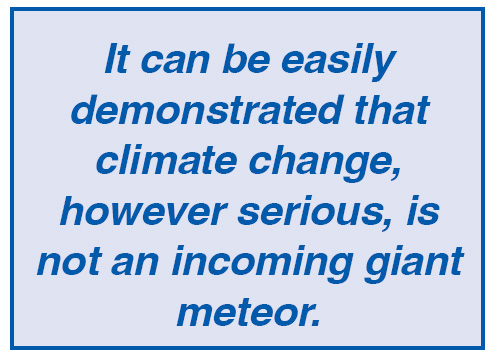Climate alarmism is based on exaggeration and falsehoods by Bjorn Lomborg
 In a recent survey of Organization for Economic Co-operation and Development countries — i.e., all the rich countries in the world — about 60 percent of respondents said they believe that global warming will likely or very likely lead to the end of mankind. This is the result of the fact that a lot of the conversation around global warming is vastly exaggerated.
In a recent survey of Organization for Economic Co-operation and Development countries — i.e., all the rich countries in the world — about 60 percent of respondents said they believe that global warming will likely or very likely lead to the end of mankind. This is the result of the fact that a lot of the conversation around global warming is vastly exaggerated.
Let me add at the outset that I am a social scientist focused on the economics of this issue, not a scientist. There is scientific dispute over the extent to which global warming is manmade. I will not weigh in on that controversy, except to concede that global warming is real, to some large extent manmade, and a serious problem.
The degree of seriousness is obviously important to address. If it is true that mankind is facing imminent destruction, we should do everything in our power to deal with it. If the world will end in twelve years if we don't address climate change, as U.S. Representative Alexandria Ocasio-Cortez claimed in 2019, she was then justified in demanding that we should spend whatever it takes to prevent that from happening.
If you think the world is ending — that climate change is the equivalent of a giant meteor hurtling towards Earth — political rhetoric of that sort makes sense. But I think it can be easily demonstrated that climate change, however serious, is not an incoming giant meteor.
U.N. Secretary General António Guterres and many Western leaders, including the current administration in the U.S., tend toward the end-of-the-world point of view: "The world is facing a grave climate emergency.... Every week brings new climate-related devastation. Floods. Drought. Heatwaves. Wildfires. Superstorms.... We are in a battle for our lives.... Climate change is the biggest threat to the global economy." These claims are echoed endlessly in the media. But are they true?
Consider the supposed rise in "superstorms" such as stronger hurricanes. What do we actually know? The annual number of hurricanes that make landfall in the U.S. since 1900 is slightly declining, not increasing. The same is true for major hurricanes (category three and above) hitting the U.S. We see the same thing if we look at world data for total hurricane energy in the satellite era, 1980-2022. In fact, 2022 was the second lowest recorded year. Did you hear that reported anywhere? No, because it doesn't fit the dominant narrative.
 What about the supposed increase in wildfires due to climate change? A typical example was the media coverage of the forest fires in Australia in 2019 and 2020, which left readers and viewers with the impression that almost all of Australia was burning. Looking at the satellite imagery, however, it was clear that although there were a lot of fires close to where the news crews lived in Sydney and Melbourne, it was one of the lowest levels of burning due to fire on record for Australia as a whole.
What about the supposed increase in wildfires due to climate change? A typical example was the media coverage of the forest fires in Australia in 2019 and 2020, which left readers and viewers with the impression that almost all of Australia was burning. Looking at the satellite imagery, however, it was clear that although there were a lot of fires close to where the news crews lived in Sydney and Melbourne, it was one of the lowest levels of burning due to fire on record for Australia as a whole.
As for the amount of burned area due to fire on a global level, satellite data shows a dramatic decline over the past 25 years. Journals like Science and Nature have covered this story, but it's not what you see on television or read in newspapers.
Perhaps the implementation of a strong climate policy might reduce instances of fire, but even if we do nothing, the number of fires will almost certainly continue to decline. In other words, the world is not going to go up in flames, contrary to what you hear from politicians or read in The New York Times.
One of the reasons it is so difficult to have a sensible conversation about the climate is because we tend only to talk about what the climate will do, not what humans will do. Sticking with the example of fires, fires are declining because human beings are intelligent and actively try to suppress fires. Humans have a wonderful ability to adapt to circumstances, and we should include that fact in the climate conversation.
How many people die overall as a result of climate, i.e., because of floods, droughts, storms, wildfires, and extreme temperatures? In the 1920s, about 500,000 people died each year, on average, due to climate. Looking at the averages in subsequent decades — the number fluctuates quite a bit from year to year — there has been a dramatic decline. In the 2010s, the average number of people dying each year as a result of climate was 18,000, and in 2022, that number dropped to about 11,000. This downward trend doesn't fit the alarmist narrative, so of course we never hear about it.
Why has this number dropped so dramatically? A big reason fewer people have been dying is that over the past century we have become wealthier. Because of that, we have the resources to develop better technology, which enables better predictive capabilities. This has nothing to do with climate and everything to do with human beings' ability to adapt. The lesson to be drawn from this is that if a country wants to reduce the number of its citizens dying as a result of climate, it should pursue economic and technological development.
Bjorn Lomborg, PhD, is president of the Copenhagen Consensus Center, a visiting fellow at the Hoover Institution, and former director of the Danish government's Environmental Assessment Institute. He has published widely and is the author of several books, including False Alarm: How Climate Change Panic Costs Us Trillions, Hurts the Poor, and Fails to Fix the Planet (2020) and most recently Best Things First: The 12 Most Efficient Solutions for the World's Poorest and Our Global SDG Promises (2023). The above article is an excerpt from a speech he delivered at a Hillsdale College National Leadership Seminar on April 24, 2023, in Irving, Texas. The complete text may be found online in the April/May 2023 edition of Imprimis, a publication of Hillsdale College, Michigan.
